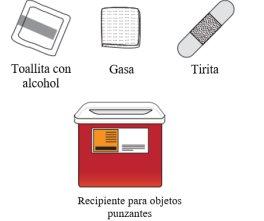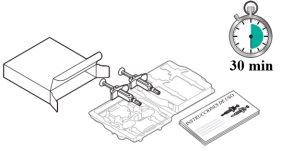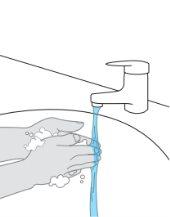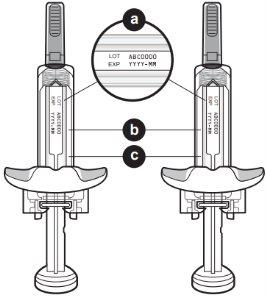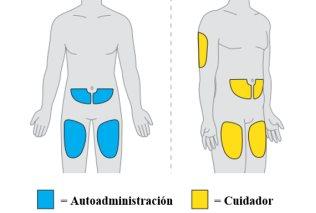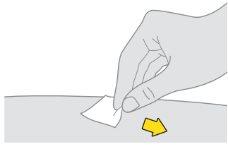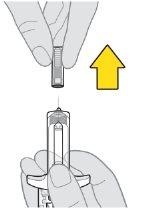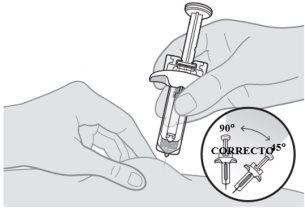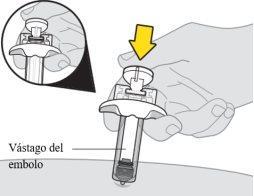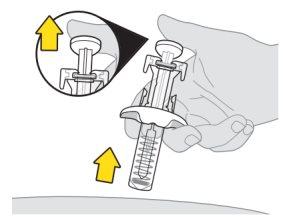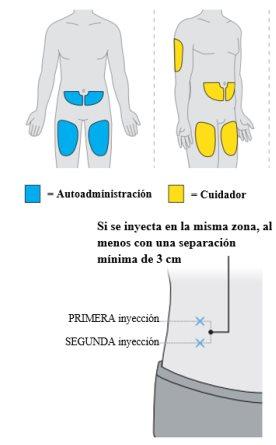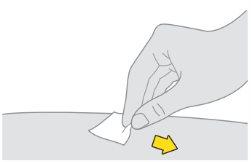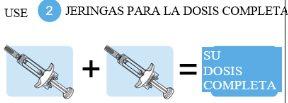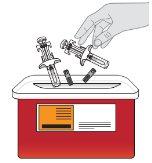
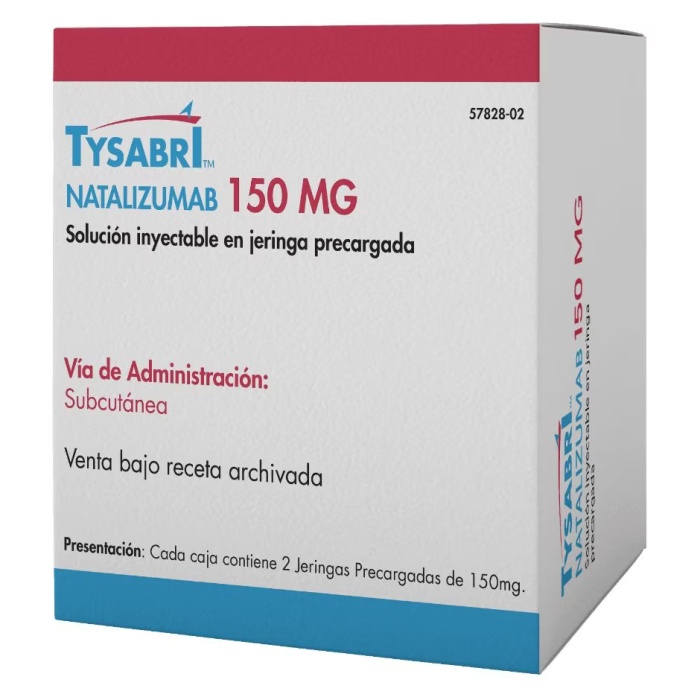
ТИЗАБРІ 150 мг розчин для ін'єкцій у попередньо заповненому шприці


Інструкція із застосування ТИЗАБРІ 150 мг розчин для ін'єкцій у попередньо заповненому шприці
Вступ
Опис: інформація для пацієнта
Тизабрі 150мг розчин для ін'єкцій у попередньо наповненому шприці
Наталізумаб
Всім пацієнтам рекомендується уважно прочитати цю інформацію перед початком використання цього лікарського засобу, оскільки вона містить важливу інформацію для вас.
Окрім цього опису, вам буде видано картку інформації для пацієнта та, у разі самолікування або лікування опікуном, Перелік перевірок перед введенням. Вони містять важливу інформацію про безпеку, яку ви повинні знати перед прийомом та під час лікування Тизабрі.
- Збережіть цей опис та картку інформації для пацієнта, оскільки вам може знадобитися знову прочитати їх. Збережіть опис та картку інформації для пацієнта з собою під час лікування та протягом шести місяців після останньої дози цього лікарського засобу, оскільки можуть виникнути побічні ефекти навіть після припинення лікування.
Якщо ви або ваш опікун вводите лікування, перегляньте Перелік перевірок перед введенням перед кожною дозою.
- Якщо у вас є якісь сумніви, проконсультуйтеся з вашим лікарем.
- Цей лікарський засіб призначений лише вам, і його не слід давати іншим людям, навіть якщо вони мають такі самі симптоми, як у вас, оскільки це може їм нашкодити.
- Якщо ви відчуваєте побічні ефекти, проконсультуйтеся з вашим лікарем, навіть якщо це побічні ефекти, які не вказані в цьому описі. Див. розділ 4.
Зміст опису:
- Що таке Тизабрі та для чого його використовують
- Що вам потрібно знати перед початком прийому Тизабрі
- Як вводиться Тизабрі
- Можливі побічні ефекти
- Збереження Тизабрі
- Зміст упаковки та додаткова інформація
1. Що таке Тизабрі та для чого його використовують
ТИЗАБРІ використовується для лікування розсіяного склерозу (РС). Він містить активну речовину наталізумаб. Це так званий моноклональний антитіл.
РС викликає запалення в мозку, яке пошкоджує нервові клітини. Це запалення відбувається, коли білі клітини крові потрапляють до мозку та спинного мозку. Цей лікарський засіб перешкоджає потраплянню білих клітин крові до мозку. Це зменшує пошкодження нервових клітин, викликане РС.
Симптоми розсіяного склерозу
Симптоми РС можуть відрізнятися від пацієнта до пацієнта; можливо, ви відчуватимете деякі з них або жодного.
До них можуть входити: проблеми з ходьбою, оніміння на обличчі, руках або ногах; проблеми з зором; втома; відчуття нестабільності або головокружіння; проблеми з сечовидільною системою та кишківником; труднощі з думкою та концентрацією уваги; депресія; гострий або хронічний біль; проблеми з сексуальною функцією; жорсткість та спазми м'язів.
Коли симптоми загострюються, це називається рецидив(також загострення або напад). Коли відбувається рецидив, ви можете відчувати симптоми раптово, протягом декількох годин, або з повільним прогресом протягом декількох днів. Симптоми зазвичай покращуються поступово (це називається ремісія).
Як Тизабрі може допомогти
У клінічних дослідженнях цей лікарський засіб зменшував приблизно вдвічі збільшення інвалідності, викликаної РС, та зменшував кількість нападів РС приблизно на дві третини. Під час лікування цим лікарським засобом ви можете не відчувати жодних покращень, але він продовжує діяти, щоб запобігти погіршенню РС.
2. Що вам потрібно знати перед початком прийому Тизабрі
Перед початком лікування цим лікарським засобом важливо, щоб ви та ваш лікар обговорили очікувані вигоди від цього лікування та пов'язані з ним ризики.
Тизабрі не слід вводити
- Якщо ви алергічні на наталізумаб або на будь-який інший компонент цього лікарського засобу (перелічені в розділі 6).
- Якщо вам діагностовано прогресивну мультифокальну лейкоенцефалопатію(ПМЛ). ПМЛ - це рідке захворювання мозку.
- Якщо у вашої імунної системи є серйозна проблема. Це може бути через захворювання (наприклад, ВІЛ-інфекцію) або через лікарські засоби, які ви приймаєте або приймали раніше (див. нижче).
- Якщо ви приймаєте лікарські засоби, які впливають на імунну систему, включно з деякими лікарськими засобами, які використовуються для лікування РС. Ці лікарські засоби не можна використовувати разом з Тизабрі.
- Якщо у вас є рак(окрім типу раку шкіри, званого базаліомою).
Попередження та обережність
Проконсультуйтеся з вашим лікарем, якщо Тизабрі є найбільш підходящим лікуванням для вас. Зробіть це перед початком використання цього лікарського засобу та коли ви прийматимете його більше двох років.
Ведіть реєстр
Для поліпшення відстеження цього лікарського засобу ваш лікар або фармацевт повинні зареєструвати назву та номер партії лікарського засобу, який вам введено, у вашій медичній документації. Ви також можете записати ці дані на випадок, якщо вам їх запитаєть пізніше.
Можлива інфекція мозку (ПМЛ)
Деякі пацієнти, які приймають цей лікарський засіб (менше 1 з 100), мали рідку інфекцію мозку, звану ПМЛ (прогресивна мультифокальна лейкоенцефалопатія). ПМЛ може викликати серйозну інвалідність або смерть.
- Перед початком лікування ваш лікар проведе аналіз кровідля виявлення інфекції вірусом JC. Вірус JC - це звичайний вірус, який зазвичай не викликає захворювання. Однак ПМЛ пов'язана з збільшенням вірусу JC в мозку. Причина цього збільшення в деяких пацієнтах, які приймають Тизабрі, неясна. Перед та під час лікування ваш лікар проведе аналіз крові для перевірки наявності антитіл до вірусу JC (анти-ВДжК), які є ознакою того, що ви інфікувалися вірусом JC.
- Ваш лікар проведе МРТ-дослідження, яке буде повторено під час лікування для виключення ПМЛ.
- Симптоми ПМЛможуть бути подібними до симптомів рецидиву РС (див. розділ 4, Можливі побічні ефекти). Ви також можете мати ПМЛ до 6 місяців після припинення лікування Тизабрі.
Найшвидше повідомте вашому лікарю, якщо ви помітили, що ваш РС погіршується або якщо ви відчуваєте нові симптоми під час лікування Тизабрі або до 6 місяців після припинення лікування.
- Повідомте вашого партнера чи опікунапро те, на що їм потрібно звернути увагу (див. також розділ 4, Можливі побічні ефекти). Деякі симптоми можуть бути важкими для виявлення самостійно, наприклад, зміни настрою або поведінки, сплутаність, труднощі з мовленням та спілкуванням. Якщо ви відчуваєте будь-який з цих симптомів, можливо, вам потрібно буде пройти додаткові дослідження. Слідкуйте за симптомами протягом 6 місяців після припинення лікування Тизабрі.
- Збережіть картку інформації для пацієнта, яку ваш лікар видав вам. Вона містить цю інформацію. Покажіть її вашому партнеру чи опікуну.
- Якщо ви або ваш опікун вводите лікування, перегляньте Перелік перевірок перед введенням перед кожною дозою.
Три речі можуть збільшити ризик ПМЛпри застосуванні Тизабрі. Якщо у вас є два або більше цих факторів ризику, ризик збільшується ще більше:
- Якщо у вас є антитіла до ВДжКв крові. Вони є ознакою того, що вірус присутній в вашому організмі. Вам буде проведено дослідження перед та під час лікування Тизабрі.
- Якщо ви приймаєте тривале лікуванняТизабрі, особливо якщо це більше двох років.
- Якщо ви приймали лікарський засіб, званийімунодепресантом, який знижує активність імунної системи.
Вірус JC також викликає інше захворювання, зване НЦГ за ВДжК (нейронопатія гранулярних клітин за вірусом JC), яке виникло в деяких пацієнтів, які приймають цей лікарський засіб. Симптоми НЦГ за ВДжК подібні до симптомів ПМЛ.
У разі пацієнтів з меншим ризиком ПМЛваш лікар може повторно проводити дослідження періодично для перевірки:
- Чи у вас ще немає антитіл до ВДжК в крові.
- Чи ви приймаєте лікування більше 2 років, чи у вас ще низький рівень антитіл до ВДжК в крові.
Якщо хтось має ПМЛ
ПМЛ можна лікувати, і лікування Тизабрі буде припинено. Однак деякі особи можуть мати реакцію, коли Тизабрі видаляється з організму. Ця реакція (відомий як СІРІабо синдром інфламації при відновленні імунної системи) може викликати погіршення стану, включно з погіршенням функції мозку.
Будьте обережні щодо інших інфекцій
Деякі інфекції, окрім ПМЛ, також можуть бути серйозними та викликані вірусами, бактеріями та іншими причинами.
Найшвидше повідомте вашому лікарю або медсестрі, якщо ви вважаєте, що у вас є інфекція (див. також розділ 4, Можливі побічні ефекти).
Зміни кількості тромбоцитів у крові
Наталізумаб може зменшувати кількість тромбоцитів у крові, які відповідають за згортання крові. Це може викликати порушення, зване тромбоцитопенією (див. розділ 4), через яке ваша кров може не згортатися достатньо швидко, щоб зупинити кровотечу. Це може викликати появу синяків, а також інші серйозні проблеми, наприклад, надмірне кровотечу. Повідомте вашому лікарю негайно, якщо ви відчуваєте необґрунтовані синяки, червоні або фіолетові плями на шкірі (звані петехіями), кровотечу з порізів на шкірі, яка не зупиняється, або супуративну, тривалу кровотечу з ясен, носа, кров у сечі або калі, або кровотечу в білій частині очей.
Діти та підлітки
Не вводіть цей лікарський засіб дітям або підліткам молодшим 18 років.
Інші лікарські засоби та Тизабрі
Повідомте вашому лікарю, якщо ви приймаєте, нещодавно приймали або можете приймати інші лікарські засоби.
- Не вводьте цей лікарський засіб, якщо ви зараз приймаєте лікарські засоби, які впливають на вашу імунну систему, наприклад, деякі лікарські засоби для лікування РС.
- Ви можете не змозі використовувати цей лікарський засіб, якщо ви коли-небудь приймали лікарські засоби, які впливають на імунну систему.
Вагітність та лактація
- Не використовуйте цей лікарський засіб, якщо ви вагітні, окрім випадків, коли ви обговорили це з вашим лікарем. Якщо ви вагітні, вважаєте, що можете бути вагітні або плануєте вагітність, негайно повідомте вашому лікарю.
- Не годуйте грудьми під час лікування Тизабрі.Ваш лікар допоможе вам вирішити, чи потрібно припинити годування грудьми або припинити лікування цим лікарським засобом.
Якщо ви вагітні, вважаєте, що можете бути вагітні або плануєте вагітність, проконсультуйтеся з вашим лікарем перед прийомом цього лікарського засобу. Ваш лікар врахує ризик для дитини та користь для матері.
Водіння транспортних засобів та використання машин
Головокружіння - це дуже частий побічний ефект. Якщо ви відчуваєте цей симптом, не водьте транспортні засоби та не використовуйте машини.
Тизабрі містить натрій
Цей лікарський засіб містить менше 1 ммоль натрію (23 мг) на дозу 300 мг; тобто, він практично не містить натрію.
3. Як вводиться Тизабрі
Ін'єкції Тизабрі призначатимуть лікар, який має досвід лікування РС. Ваш лікар може змінити ваше лікування з іншого лікарського засобу на Тизабрі, якщо немає ознак проблем, викликаних попереднім лікуванням.
- Ваш лікар призначить аналіз кровідля виявлення антитіл до ВДжК та інших можливих проблем.
- Ваш лікар проведе МРТ-дослідження, яке буде повторено під час лікування.
- Для зміни деяких лікарських засобів для РСваш лікар може порекомендувати вам чекати певний час, щоб переконатися, що більша частина попереднього лікарського засобу була видалена з вашого організму.
- Якщо ваш стан дозволяє, ваш лікар може обговорити з вами можливість отримання ін'єкцій поза лікарнею (наприклад, вдома). Ці ін'єкції можуть вводити медичний працівник, ви самі або ваш опікун, якщо ви відповідаєте певним критеріям. Ви продовжуватимете відвідувати лікарню або медичний центр для прийому та періодичних аналізів крові та МРТ-досліджень.
- Якщо ваш лікар вирішить, що ви підходите для самолікування (або лікування опікуном), медичний працівник буде наглядати за вами під час введення перших двох доз (по 2 ін'єкції кожна).
- Медичний працівник надасть вам або вашому опікуну детальні інструкції та покаже, як підготувати та ввести лікарський засіб перед першим використанням шприців.
- Якщо ваш лікар вирішить, що ви підходите для самолікування (або лікування опікуном), переконайтеся, що ви прочитали картку інформації для пацієнта, щоб переглянути перелік симптомів ПМЛ та Перелік перевірок перед введенням перед кожною дозою. Якщо з'являється або погіршується будь-який симптом, не вводьте дозу та негайно зверніться до вашого лікаря.
- Рекомендована доза для дорослих становить 300 мг один раз на чотири тижні.
- Кожна доза вводиться у дві ін'єкціїпід шкіру, в стегно, живіт (не менше 6 сантиметрів від пупка) або задню частину руки (тільки у разі ін'єкції медичним працівником або опікуном). Введення триває до 30 хвилин.
- У кінці опису міститься інформація про те, як підготувати та ввести лікарський засіб.
Якщо ви припините лікування Тизабрі
Важливе значення має безперервне лікування Тизабрі, особливо протягом перших місяців лікування. Важливо продовжувати лікування, поки ви та ваш лікар не вирішите, що воно вам допомагає. Не припиняйте прийом лікарського засобу без поради вашого лікаря. Пацієнти, які прийняли одну або дві дози Тизабрі, а потім зробили перерву в лікуванні тривалістю 3 місяці або більше, мали більшу ймовірність появи алергічної реакції при відновленні лікування.
Перевірка на алергічні реакції
Деякі пацієнти мали алергічну реакцію на цей лікарський засіб. Ваш лікар перевірятиме, чи з'являються алергічні реакції під час ін'єкцій та протягом однієї години після них. У разі самолікування або лікування опікуном, якщо ви відчуваєте алергічну реакцію, припиніть ін'єкцію та негайно зверніться до лікаря. Див. також розділ 4, Можливі побічні ефекти.
Якщо ви забули ввести Тизабрі
Якщо ви не отримали звичайну дозу Тизабрі, проконсультуйтеся з вашим лікарем, щоб він якомога швидше призначив її вам. Після цього ви можете продовжувати прийом Тизабрі кожні 4 тижні.
Для отримання повної дози необхідно вввести дві шприци. Важливо ввести обидві шприцита дотримуватися призначеної схеми введення. Якщо ви або ваш опікун вводите ін'єкції та пропустили дозу або ввели лише одну шприцу, негайно зверніться до вашого лікаря за порадою.
Чи Тизабрі завжди буде ефективним?
У деяких пацієнтів, які приймають Тизабрі, природні захисні сили організму можуть перешкоджати правильній дії лікарського засобу з часом, оскільки організм виробляє антитіла до лікарського засобу. Ваш лікар може вирішити, чи лікарський засіб не діє правильно, на основі аналізу крові, та припинити лікування, якщо це необхідно.
Якщо у вас є якісь інші питання щодо використання Тизабрі, проконсультуйтеся з вашим лікарем. Слідуйте точно інструкціям щодо введення лікарського засобу, вказаним у цьому описі або призначеним вашим лікарем. У разі сумнівів проконсультуйтеся з вашим лікарем.
Підшкірно позначається як СК на етикетці шприца.
4. Можливі побічні ефекти
Як і всі лікарські засоби, цей лікарський засіб може викликати побічні ефекти, хоча не всі люди їх відчувають.
Повідомте своєму лікарю або медсестрі негайно, якщо ви спостерігатимете будь-які з наступних симптомів.
Ознаки інфекції мозку
- Зміни в особистості та поведінці, такі як сплутаність, марення або втрата свідомості
- Припадки (епілептичні напади)
- Головний біль
- Нудота/вомота
- Ригідність шиї
- Гіперчутливість до яскравого світла
- Лихоманка
- Висип на шкірі (на будь-якій частині тіла)
Ці симптоми можуть бути ознаками інфекції мозку (енцефаліт або ЛМП) або оболонки, що його оточує (менінгіт).
Ознаки інших серйозних інфекцій
- Непоясненна лихоманка
- Серйозна діарея
- Недостатність дихання
- Тривалий головокружіння
- Головний біль
- Втрата ваги
- Недостатність енергії
- Порушення зору
- Біль або червоність ока(ів)
Ознаки алергічної реакції
- Кропив'янка (висип з свербінням)
- Набухання обличчя, губ або язика
- Затруднення дихання
- Біль або дискомфорт у грудній клітці
- Збільшення або зменшення артеріального тиску (ваш лікар або медсестра попередять вас, якщо вони контролюють ваш тиск)
Більш імовірно, що вони трапляються під час або незабаром після ін'єкції.
Ознаки можливої проблеми з печінкою
- Жовті плями на шкірі або білому очному яблуці
- Незвичайне потемніння сечі
- Аномальні показники функції печінки
Якщо ви відчуваєте будь-які з побічних ефектів, описаних вище, або якщо ви вважаєте, що у вас інфекція п повідомте своєму лікарю або медсестрі негайно. Покажіть свою картку інформації для пацієнтаі цей лист будь-якому лікарю або медсестрі, який вас лікує, не тільки вашому нейрологу.
Інші побічні ефекти
Дуже часті(можуть впливати на понад 1 з 10 осіб)
- Інфекція сечовивідних шляхів
- Біль у горлі та кон'юнктивіт або виділення з носа
- Головний біль
- Головокружіння
- Чувство нездоров'я (нудота)
- Біль у суглобах
- Втома
Часті(можуть впливати на 1 з 10 осіб)
- Анемія (зниження кількості червоних кров'яних тілець, що може зробити вашу шкіру блідою та викликати відчуття безсилля або втоми)
- Алергія (гіперчутливість)
- Озноб
- Кропив'янка (висип з свербінням)
- Вомота
- Лихоманка
- Затруднення дихання (диспное)
- Червоність обличчя або тіла (рубор)
- Інфекції, викликані вірусом герпесу
- Дискомфорт навколо місця ін'єкції. Можуть бути біль, синяки, червоність, свербіння або набухання
Менш часті(можуть впливати до 1 з 100 осіб)
- Алергічна реакція (анafilактичний шок)
- Лейкоенцефалопатія мультифокальна прогресивна (ЛМП)
- Запальний розлад після припинення лікарського засобу
- Набухання обличчя
- Збільшення кількості білих кров'яних тілець (еозінофілія)
- Зниження кількості тромбоцитів
- Легке утворення синяків (пурпура)
Рідкісні(можуть впливати до 1 з 1000 осіб)
- Інфекція вірусом герпесу в оці
- Анемія важка (зниження кількості червоних кров'яних тілець, що може зробити вашу шкіру блідою та викликати відчуття безсилля або втоми)
- Інтенсивне набухання під шкірою
- Високі рівні білірубіну в крові (гіпербілірубінемія), що можуть викликати симптоми, такі як жовті плями на очах або шкірі, лихоманка та втома
Частота невідома(не може бути оцінена на основі наявних даних)
- Рідкісні інфекції мозку та очей
- Ушкодження печінки
Повідомте своєму лікарю якнайшвидше, якщо ви вважаєте, що у вас інфекція.
Ви також знайдете цю інформацію на картці інформації для пацієнта, яку ваш лікар вам дав.
Звіт про побічні ефекти
Якщо ви відчуваєте будь-який побічний ефект, повідомте своєму лікарю, навіть якщо це можливі побічні ефекти, які не вказані в цьому листі. Ви також можете повідомити про них безпосередньо через національну систему повідомлення, включену до Додатку V. Повідомлення про побічні ефекти допоможе вам забезпечити більше інформації про безпеку цього лікарського засобу.
5. Зберігання ТІСАБРІ
Тримайте цей лікарський засіб поза зоною видимості та досягнення дітей.
Не використовуйте цей лікарський засіб після закінчення терміну придатності, вказаного на етикетці та коробці. Термін придатності - останній день місяця, який вказано.
Зберігайте в холодильнику (між 2 °C та 8 °C).
Не заморожуйте.
Зберігайте шприци в зовнішній упаковці, щоб захистити їх від світла.
Шприци з попередньо наповненим ліками можна зберігати при кімнатній температурі (до 30 °C) протягом максимального комбінованого часу до 24 годин, включно з часом, необхідним для досягнення кімнатної температури для введення. Шприци можна повернути в холодильник і використовувати до закінчення терміну придатності, вказаного на етикетці та коробці. Дата та час, коли упаковку вийнято з холодильника, повинні бути вказані на коробці. Викиньте шприци, якщо вони залишаються поза холодильником понад 24 години. Не використовуйте зовнішні джерела тепла, такі як гаряча вода, для нагрівання шприців з попередньо наповненим ліками.
Не використовуйте цей лікарський засіб, якщо ви спостерігатимете частинки в рідині або зміни кольору рідини.
6. Зміст упаковки та додаткова інформація
Склад Тисабрі
Активна речовина - наталізумаб.
Кожна попередньо наповнена шприц-дозатор містить 150 мг наталізумабу.
Інші компоненти:
Монобазичний фосфат натрію моногідрат
Дибазичний фосфат натрію гептахідрат
Хлорид натрію (див розділ 2 «Тисабрі містить натрій»)
Полісорбат 80 (Е 433)
Вода для ін'єкційних препаратів
Вигляд продукту та вміст упаковки
Тисабрі - безбарвна або легенько жовта рідина, легенько опалесцентна або опалесцентна.
Кожна коробка містить дві шприц-дозатори.
Тисабрі випускається в упаковках, які містять 2 попередньо наповнені шприц-дозатори.
Власник дозволу на маркетинг та відповідальна особа за виробництво
Biogen Netherlands B.V.
Prins Mauritslaan 13
1171 LP Badhoevedorp
Нідерланди
Відповідно до цього препарату можна отримати додаткову інформацію, звернувшись до місцевого представника власника дозволу на маркетинг:
Бельгія/Бельгія/Бельгія Biogen Belgium N.V./S.A. Тел./Телефон: +32 2 219 12 18 | Литва Biogen Lithuania UAB Телефон: +370 5 259 6176 |
| Люксембург/Люксембург Biogen Belgium N.V./S.A. Тел./Телефон: +352 2 219 12 18 |
Чехія Biogen (Чехія) s.r.o. Телефон: +420 255 706 200 | Угорщина Biogen Hungary Kft. Телефон: +36 (1) 899 9883 |
Данія Biogen (Данія) A/S Телефон: +45 77 41 57 57 | Мальта Pharma MT limited Телефон: +356 213 37008/9 |
Німеччина Biogen GmbH Телефон: +49 (0) 89 99 6170 | Нідерланди Biogen Netherlands B.V. Телефон: +31 20 542 2000 |
Естонія Biogen Estonia OÜ Телефон: +372 618 9551 | Норвегія Biogen Norway AS Телефон: +47 23 40 01 00 |
Греція Genesis Pharma SA Телефон: +30 210 8771500 | Австрія Biogen Austria GmbH Телефон: +43 1 484 46 13 |
Іспанія Biogen Spain SL Телефон: +34 91 310 7110 | Польща Biogen Poland Sp. z o.o. Телефон: +48 22 351 51 00 |
Франція Biogen France SAS Телефон: +33 (0)1 41 37 95 95 | Португалія Biogen Portugal Sociedade Farmacêutica Unipessoal, Lda Телефон: +351 21 318 8450 |
Хорватія Biogen Pharma d.o.o. Телефон: +358 (0) 1 775 73 22 | Румунія Johnson & Johnson Romania S.R.L. Телефон: +40 21 207 18 00 |
Ірландія Biogen Idec (Ірландія) Ltd. Телефон: +353 (0)1 463 7799 | Словенія Biogen Pharma d.o.o. Телефон: +386 1 511 02 90 |
Ісландія Icepharma hf Телефон: +354 540 8000 | Словаччина Biogen Slovakia s.r.o. Телефон: +421 2 323 340 08 |
Італія Biogen Italia s.r.l. Телефон: +39 02 584 9901 | Фінляндія Biogen Finland Oy Телефон: +358 207 401 200 |
Кіпр Genesis Pharma (Кіпр) Ltd Телефон: +357 22 76 57 15 | Швеція Biogen Sweden AB Телефон: +46 8 594 113 60 |
Латвія Biogen Latvia SIA Телефон: +371 68 688 158 |
Дата останнього перегляду цієї інструкції:05/2025
Інші джерела інформації
Детальна інформація про цей препарат доступна на сайті Європейського агентства з лікарських засобів: https://www.ema.europa.eu
--------------------------------------------------------------------------------------------------------------------
ІНСТРУКЦІЇ ЗАСТОСУВАННЯ
Тисабрі 150мг
розчин для ін'єкцій
наталізумаб
підшкірна ін'єкція
Повна доза=дві попередньо наповнені шприц-дозатори
Ці «Інструкції з застосування» містять інформацію про те, як вводити препарат за допомогою попередньо наповненого шприц-дозатора Тисабрі.
Прочитайте ці Інструкції з застосування перед тим, як почати використовувати попередньо наповнений шприц-дозатор Тисабрі (у цих інструкціях називається «шприц-дозатор»), і кожен раз, коли ви отримуєте нову упаковку. Можливо, є нова інформація.
Ця інформація не замінює консультацію з вашим лікарем про ваше захворювання або лікування.
Частини пристрою Тисабрі
Не знімайте кришки-держаки. Кришки-держаки дозволять вам тримати шприц-дозатор міцніше під час процесу ін'єкції.
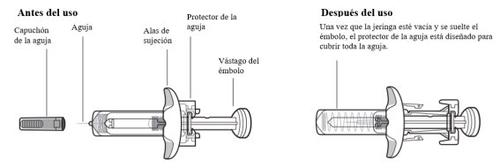
Важлива інформація, яку потрібно знати перед введенням Тисабрі
Тисабрі випускається в попередньо наповненому шприц-дозаторі (у цих інструкціях називається «шприц-дозатор»). Кожна коробка Тисабрі містить дві шприц-дозатори. Ви повинні використовувати обидва шприц-дозатори протягом максимально 30 хвилин один за одним, щоб отримати повну дозу.
- У разі самозастосування або введення препарату опікуном ваш лікар повинен навчити вас або вашого опікуна, як підготувати та вводити шприц-дозатори перед їхнім першим застосуванням. Якщо ви або ваш опікун вводите ін'єкції та пропустили дозу або ввели тільки один шприц-дозатор, зверніться до вашого фармацевта або лікаря.
- Шприц-дозатори призначені тільки для підшкірного введення (введення безпосередньо в жировий шар під шкірою).
- Кожен шприц-дозатор можна використовувати тільки один раз (один раз). Їх не можна повторно використовувати.
- Не діліться шприц-дозаторами з іншими людьми, навіть якщо вони мають те саме захворювання, що і ви. Ви можете заразити їх інфекцією або заразитися від них.
Примітка для медичних працівників:
Пацієнтів потрібно спостерігатипід час підшкірних ін'єкцій та протягом 1 години післявведення для виявлення ознак і симптомів реакцій на ін'єкцію, включаючи гіперчутливість. Після перших шести доз Тисабрі, незалежно від способу введення, пацієнтів потрібно спостерігати після підшкірної ін'єкції за медичним судженням.
Зберігання Тисабрі
- Тримайте шприц-дозатор та всі ліки поза зоною досяжності дітей.
- Зберігайте шприц-дозатори в холодильнику (між 2 °C та 8 °C).
- У разі необхідності шприц-дозатори можна зберігати при кімнатній температурі (до 30 °C) та протягом 24 годин загалом. Якщо шприц-дозатори перебували поза холодильником понад 24 години, не використовуйте їх.
- Зберігайте шприц-дозатори в оригінальній упаковці, щоб захистити їх від світла.
- Не заморожуйте шприц-дозатори та не піддавайте їх впливу температур вище 30 °C.
- Шприц-дозатори можна повернути до холодильника та використовувати до закінчення терміну придатності, вказаного на етикетці та упаковці.
Підготовка ін'єкції Тисабрі:
|
|
|
|
Не використовуйте зовнішні джерела тепла, такі як гаряча вода, для нагрівання шприц-дозаторів. | |
|
|
|
|
Не використовуйте шприц-дозатор, якщо він просрочений. | |
| |
Не використовуйте шприц-дозатор, якщо він пошкоджений або тріскний. | |
| |
Не використовуйте шприц-дозатор, якщо рідина містить видимі частинки. Не використовуйте шприц-дозатор, якщо він впав до використання. Повідоміть вашого лікаря, якщо у вас виникли якісь проблеми з шприц-дозаторами | |
Ви можете побачити бульбашки в лікарському засобі. Це нормально. Примітка:вигляд лікарського засобу може змінитися після видалення з холодильника. Це нормально | |
|
|
|
|
Не торкайтеся, не шануйте та не дуйте на очищену зону. |
Введення першого шприц-дозатора
Примітка:ви можете побачити краплю рідини на кінчику голки. Це нормально. |
|
| |
|
|
|
|
Переконайтеся, що ви потягнули за поршень до кінця, щоб ввезти весь лікарський засіб та щоб захисник голки увійшов у місце. | |
|
|
Якщо захисник голки не активувався для закриття голки, не повертайте захисник на шприц-дозатор. Помістіть його до контейнера для гострих предметів та зверніться до вашого лікаря за допомогою. | |
|
|
Введення другого шприц-дозатора
|
|
|
|
Не торкайтеся, не шануйте та не дуйте на очищену зону. | |
Введіть ін'єкції одну за одною без значної затримки. Друга ін'єкція повинна бути введена не пізніше 30 хвилин після першої. |
|
Видалення Тисабрі
|
|
Не викидайте контейнер для гострих предметів чи використані шприц-дозатори до домашнього сміття. | |
Якщо у вас немає контейнера для гострих предметів, ви можете попросити його у вашого лікаря або можете використовувати домашній контейнер, який:
Коли контейнер для гострих предметів буде майже повний, слідувати інструкціям вашої громади щодо правильного видалення. Можуть бути державні або місцеві правила щодо видалення використаних шприц-дозаторів. Не викидайте контейнер для гострих предметів, який був використаний, до домашнього сміття, якщо тільки правила вашої громади не дозволяють цього. Не переробляйте контейнер для гострих предметів. |
- Країна реєстрації
- Діючі речовини
- Потрібен рецептТак
- Виробник
- Інформація є довідковою і не є медичною порадою. Перед прийомом будь-яких препаратів обов'язково проконсультуйтеся з лікарем. Oladoctor не несе відповідальності за медичні рішення, прийняті на основі цього контенту.
- Альтернативи до ТИЗАБРІ 150 мг розчин для ін'єкцій у попередньо заповненому шприціФорма випуску: РОЗЧИН ДЛЯ ІНФУЗІЙ, ЩО ВВОДИТЬСЯ ІН'ЄКЦІЙНО, 300 мгДіючі речовини: natalizumabВиробник: Sandoz GmbhПотрібен рецептФорма випуску: РОЗЧИН ДЛЯ ІНФУЗІЙ, ЩО ВВОДИТЬСЯ ІН'ЄКЦІЙНО, 20 мгДіючі речовини: natalizumabВиробник: Biogen Netherlands B.V.Потрібен рецептФорма випуску: РОЗЧИН ДЛЯ ІНФУЗІЙ, ЩО ВВОДИТЬСЯ ІН'ЄКЦІЙНО, 120 мг (80 мг/кг) белімумабДіючі речовини: belimumabВиробник: Glaxosmithkline (Ireland) LimitedПотрібен рецепт
Лікарі онлайн щодо ТИЗАБРІ 150 мг розчин для ін'єкцій у попередньо заповненому шприці
Консультація щодо дозування, побічних ефектів, взаємодій, протипоказань та поновлення рецепта на ТИЗАБРІ 150 мг розчин для ін'єкцій у попередньо заповненому шприці – за рішенням лікаря та згідно з місцевими правилами.




